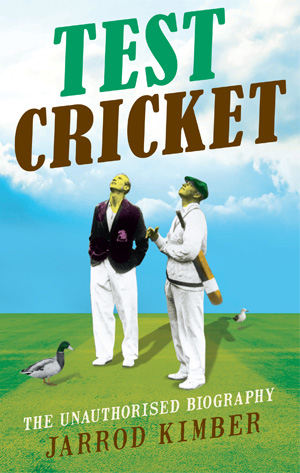 |
||
| ABOUT ME | SOME INTERESTING CRICKET FACTS | BOOK REVIEWS | EVENTS | CONTACTS | ||
 |
Test Cricket - The unauthorised Biography by Jarrod Kimber
|
|
While chronicling of Test match cricket, Jarrod Kimber takes cricket enthusiasts through all the seismic events in cricket's tragicomic history, from its accidental birth to its run-in with death. Lords, maharajahs and refugees have all played the game that has survived many wars, corruption and terrorism to still be standing - still be captivating - today.
The 298-page book concentrates on the stories behind the cricketing legends, great matches and teams. It has 63 chapters, some of them no longer than a couple of pages. The publication explores some of the controversial and legendary moments of the cricket world's most loved sporting competition and contains little snippets throughout, providing interesting bits of trivia.
Women's cricket has been paid more attention in the book than the authorities once provided to it. The author says that the women had to pay to play. In a chapter on the Woman who created the World Cup, we have been informed that Rachael Heyhoe-Flint hit the first six in a women's Test. She had batted for 521 minutes to post a World record innings of 179 (since surpassed) against Australia at The Oval in July 1976 to ensure a draw. She averaged 45.54 in Tests, including three centuries and ten fifties - her tally being 1594 runs in 22 Tests. In ODIs, she managed 643 runs (ave.58.45) in 23 Tests, including a hundred and four fifties.
Jarrod Kimber remarked: "She was the cricketer of her time. Of all time. But her legend is not just that of a player: it is that of the woman who brought women's cricket to the world. She made people talk about it. She stood on street corners taking donations. She found sponsors. She wrote about the game as a journalist, often writing match reports of matches she was in, just to make sure someone covered them."
Vivian Richards' dismissal as caught by Kapil Dev in the 1983 World Cup final on a damp day at Lord's has been described splendidly by the author: "Dev took something like 18 steps. He had to run at close to full pace, while looking back over his shoulder. There was not a moment when it looked like he would do anything other than catch it. But that catch won the match. It won the World Cup. It changed cricket. Had Dev dropped that, India most probably would have lost that match. Instead India was number one. Number one, at the home of cricket, against the greatest team the sport had produced. From that day onwards, all sport, and most of life, took a backseat to cricket in India. Dev caught the World Cup and delivered a superpower.
The author believes calling Aubrey Faulkner a genuine all-rounder seems like an understatement. "Hell, his fielding was so good he could have got selected for that alone. They say he was so good looking that women just came to watch him. He was every damn thing. Faulkner was the sort of all-rounder that South Africa seems to produce while the rest of the world is hoping for one. Aubrey Faulkner was Mike Procter, Clive Rice and Jacques Kallis before any of them existed."
Victor Trumper was cricket's first ethereal beauty, according to the author. He says Trumper and WG Grace helped form what people now refer to as cricket's Golden Era, which lasts from 1890 until the outbreak of World War I in 1914.
The author says the English women who toured Australia in 1934-35 were all single. Married women were simply not allowed to be away from their families. These single women had to pay Sterling pounds 80 per head for the honour of representing their country. They were also told not to smoke, drink or gamble or 'be accompanied by a man'.
Sydney Barnes, according to Jarrod Kimber, was one of the few bowlers in the history of the game to be a successful quick spinner. Barnes could get the ball to lift, he could bowl off-spin, he could bowl leg-spin, he could swing the ball and he was actually quick. He could succeed on any pitch. He was the Frankenstein's monster of bowlers.
The book has a few minor mistakes - typographical or otherwise. The same were required to be rectified at the proofreading stage. Hedley Verity's first name has been spelt as Headley. Tom Cartwright as Tim and Madan Lal as Madal.
Jarrod Kimber is a cricket writer who came to prominence as the founder of the cricketwithballs blog. He was the editor of SPIN cricket magazine in 2011 and is currently working for ESPNCricinfo writing for The Cricket Sadist Hour blog and starring in The Chuck Fleetwood-Smiths video series.
|
||
Home | About | Cricket Facts | Book Reviews | Events | Contacts | Sitemap | Disclaimer
© Rajesh Kumar 2010 all right reserved